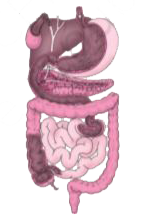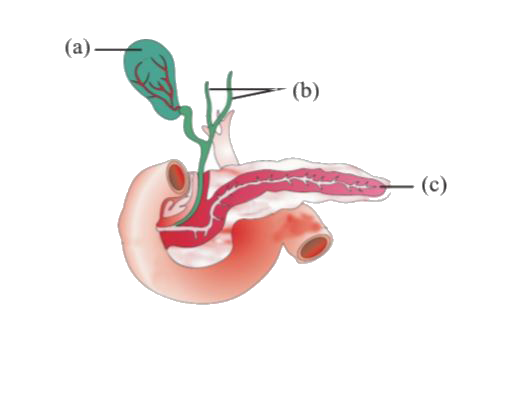
Label the following parts in Figure 2.2 and name them.
(a) The largest gland in our body.
(b) The organ where protein digestion starts.
(c ) The organ that releases digestive juice into the small intestine.
(d) The organ where bile juice gets stored.
Step by step video & image solution for Label the following parts in Figure 2.2 and name them. (a) The largest gland in our body. (b) The organ where protein digestion starts. (c ) The organ that releases digestive juice into the small intestine. (d) The organ where bile juice gets stored. by Biology experts to help you in doubts & scoring excellent marks in Class 7 exams.
Updated on:21/07/2023Topper's Solved these Questions
- NUTRITION IN ANIMALSBOOK - NCERT EXEMPLARCHAPTER - NUTRITION IN ANIMALSEXERCISE - Short answer questions
6 Videos
- FORESTS : OUR LIFELINEBOOK - NCERT EXEMPLARCHAPTER - FORESTS : OUR LIFELINEEXERCISE - LONG ANSWER QUESTIONS
10 Videos
- NUTRITION IN PLANTSBOOK - NCERT EXEMPLARCHAPTER - NUTRITION IN PLANTSEXERCISE - Long answer questions
4 Videos
Similar Questions
Many secretory glands are present in the digestive glands. Thiese glands release digestive juices for the digestion of food. Which organ of the digestive system secretes bile?
View SolutionRead the following passage carefully and answer the questions that follows it.
Bile juice is stored in a sac called gall bladder, located near its organ of secretion, liver. The gall bladder releases the bile juice into the small intestine whenever food reaches there. Though bile juice is devoid of any digestive enzymes, it is required for the digestion of fats. The fats cannot be digested easily because they are insoluble in water and are present as large globules. Bile juice breaks down big fat droplets into smaller droplets. These are then easily digested by the enzymes released from the pancreas.
(a) Which organ secretes the bile juice ?
(b) Why is digestion of fats difficult as compared to that of other nutrients ?
(c ) How does bile juice help in digestion of fat ?
(d) Where is the digestion of fat completed ?
(e ) Does bile juice digest fat completely ?
View Solution
Knowledge Check
In given figure organs are labelled as a,b and c. find the organ whose secretion contains lipid digesting enzyme :-
 AaBcCa and cDb
AaBcCa and cDbRead the following statements A-D
(a) The stomach stores the food for 4-5 hours
(b) The food mixes throughly with the acidic intestinal juice
(c) Trypsinogen is activated by an enzymeenterogastrone, secreted by the intestinal mucosa
(d) Renin is enzyme found in gastric juice of infants which helps in digestion of milk protein How many of the above statements are wrong?AFourBOneCTwoDThree
Draw diaggram of human alimentary canal and lable the following : (i) Part in which starch digestion is initiated.
(ii) Orgen in which bile is stored.
(iii) The gland that secretes digestive enzymes as well as hormones.
(iv) Part of alimentary cancel where water is reabsorbed.
(v) Part of gul where finger like projections are present to facilitate absorption of digested food .
View SolutionIn the figure of a flower given in Figure 12.4, label the parts whose functions are given below and give their names
(a) The part which contains pollen grains.
(b) The part where the female gamete is formed
(c ) The female reproductive part where pollen grains germinate.
(d) The colourful part of flower which attracts insects

View Solution(a) Draw a diagram of human alimentary canal and label the following parts:
(i) largest gland.
(ii) gland that secretes digestive enzymes and hormone.
(iii) Part where HCl is produced.
(iv) part where digested food is absorbed.
(b) What are villi? Explain their function in the digestive system.
View SolutionIdentify the organ where 90 per cent of the food gets digested and also explain its different parts.
View SolutionThe pka of acetyl salicylic acid (aspirin) is 3.5. The pH of gastric juice in the human stomach is about 2-3 and the pH in the small intestine is about 8. Aspirin will be
(a) un-ionised in the small intestine and in the stomach
(b) completely ionised in the small intestine and in the stomach
(c) ionised in the stomach and almost un-ionised in the small intestine
(d) ionised in the small intestine and almost un-ionised in the stomach
View SolutionDescribe the following processes in the body.
(a) Coagulation of milk in alimentary canal.
(b) Digestion of fats in the intestine.
(c ) Digestion of starch in the alimentary canal.
(d) Role of bile salts in the digestion and absorption of fats.
(e ) Microbial digestion of cellulose in the herbivore alimentary canal.
View Solution
